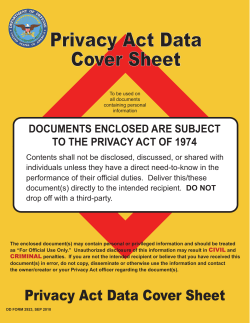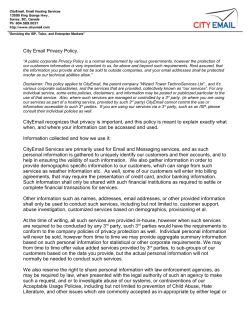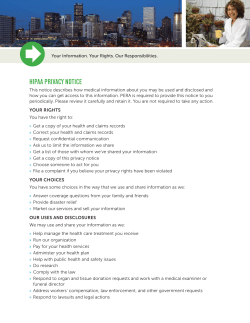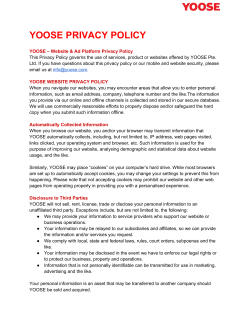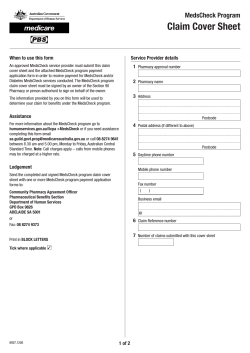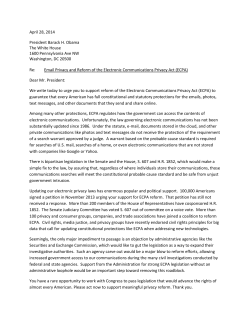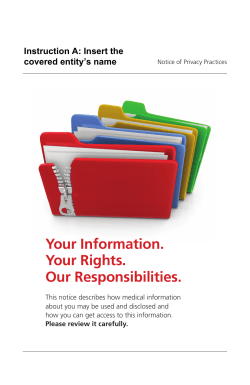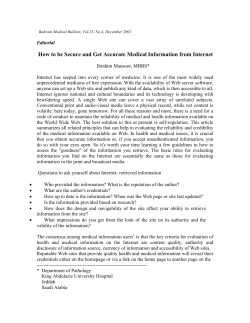
Cybersecurity Threats and Trends
Cybersecurity Threats and Trends Man-in-the-middle / Man-in-the-browser botnets/malware trojan horses Ransomware Distributed DDoS code development security weaknesses Attack Trends “stealth” / advanced scanning techniques denial of service (DoS) packet spoofing network sniffers sweepers back doors disabling audits mobile malware credential stealing Phishing/Pharming cross site scripting SQL Injections website defacement automated probes/scans hijacking burglaries sessions exploiting known vulnerabilities password cracking self-replicating code password guessing 1980 1990 2000 2010 2013/2014 Threats: • Malware shows no sign of changing its steady growth, which has risen steeply since 2012. • Financial Institutions are the most targeted, suffering 80% of all malware attacks. • The trend moving forward shows increase sophistication in the mode of attack and the persistence of fraudsters. • Mobile platforms represent a major growth area for vulnerabilities, as well as malware attacks. 1 Cybersecurity Regulatory Compliance outlook • Cybersecurity Assessments – – – – Type Mitigating Controls Effectiveness of the controls Residual risk • Vendor Risk Assessments – – – – – – Critical services Outsourcing (i.e. SaaS, IaaS, etc.) Legal Information Security Operational Risk Financial • Incident Response – – – – – Develop ant test your IR Plan Emergency response services (Know who to call) Forensic analysis Escalation procedures Notification to the regulator (State, Fed, OCC, etc.) – Notification to law enforcement Take Away • Do your Part: – – – – Be proactive Identify and manage risks Apply defense-in-depth measures Ensure your vendors have the required controls in place to safeguard YOUR Bank’s information - Trust but verify – Establish a culture of security – Join an Information Sharing support group Be Aware - Anticipate - Adapt security Is cloud computing secure? Where is my data and do I have access? How do you support my compliance needs? compliance What does privacy mean? Is my data used for advertising? privacy - Forbes, 2013 Microsoft Core Values Security Compliance Privacy business Trustworthy practices Computing reliability …across places, contexts, and devices? privacy security Security Best-in-class security with over a decade of experience building Enterprise software & Online services • Physical and data security with access control, encryption and strong authentication • Security best practices like penetration testing, Defense-in-depth to protect against cyber-threats • Unique customer controls with Rights Management Services to empower customers to protect information Compliance Commitment to industry standards and organizational compliance • Enable customers to meet global compliance standards in ISO 27001, EUMC, HIPAA, FISMA • Contractually commit to privacy, security and handling of customer data through Data Processing Agreements • Admin Controls like Data Loss Prevention, Legal Hold, E-Discovery to enable organizational compliance Privacy Privacy by design with complete separation of Enterprise and Consumer services • No mining of data for advertising • Transparency with the location of customer data, who has access and under what circumstances • Customer have greater control over privacy to enable or regulate sharing based on organizational needs Built in Capabilities Security best practices like penetration testing, Defense-in-depth to protect against cyberthreats Flexible Customer Controls • Physical and data security with access control, encryption and strong authentication • Unique customer controls with Rights Management Services to empower customers to protect information Built in Capabilities Office 365 is built with a focus on privacy and security that allows us to obtain important industry certifications and enables customers to meet international laws and regulations 3rd party certification and audits. Customer controls for compliance • Data Loss Prevention (DLP) • Archiving and Legal Hold • E-Discovery Policy Control Framework Standards Business rules for protecting information and systems which store and process information A process or system to assure the implementation of policy System or procedural specific requirements that must be met Step-by-step procedures Operating Procedures Certification Status CERT Queued or In Progress MARKET REGION Customers can request a copy of the latest audit reports and a accreditation artifacts ‘Right to Examine’ vs. ‘Right to Audit’ Compliance Program Preserve Auditing and retention policies Log events, view, edit, delete email messages, documents, task lists, issues lists, discussion groups, and calendars. View audit data, and report and summarize current usage Search In-Place Archive Governance Hold Secondary mailbox with separate quota Automated and timebased criteria Managed through EAC or PowerShell Set policies at item or folder level Capture deleted and edited email messages Available onpremises, online, or through EOA Expiration date shown in email message Time-Based In-Place Hold Granular QueryBased In-Place Hold Optional notification Data Loss Prevention Identify, monitor, and protect sensitive data Proactively identifies sensitive information and alerts users via “PolicyTips” Customize the level of restrictions eDiscovery Web-based eDiscovery Center and multi-mailbox search Search primary, InPlace Archive, and recoverable items Delegate through roles-based administration De-duplication after discovery Auditing to ensure controls are met No Advertising Transparency Privacy controls • No advertising products out of Customer Data • No scanning of email or documents to build analytics or mine data • Access to information about geographical location of data, who has access and when • Notification to customers about changes in security, privacy and audit information • Various customer controls at admin and user level to enable or regulate sharing • If the customer decides to leave the service, they get to take to take their data and delete it in the service Data Sovereignty • Microsoft will not disclose Customer Data to law enforcement unless required by law. • Microsoft will attempt to redirect law enforcement to request data directly from Customer. • Microsoft will notify Customer and provide a copy of the demand unless legally prohibited from doing so. • Microsoft will continue to challenge government demands to shape the limits of the law. Will you use my data to build advertising products? We do not mine your data for advertising purposes. It is our policy to not use your data for purposes other than providing you productivity services. We design our Office 365 commercial services to be separate from our consumer services so that there is no mixing of data between the two. Who owns the data I put in your service? You own your data and retain the rights, title, and interest in the data you store in Office 365. You can take your data with you, whenever you want. Learn more about data portability and how we use your data. Where is Data Stored? Clear Data Maps and Geographic boundary information provided ‘Ship To’ address determines Data Center Location Who accesses and what is accessed? Core Customer Data accessed only for troubleshooting and malware prevention purposes . Core Customer Data access is limited to key personnel on an exception basis only. Do I get notified? Microsoft notifies you of changes in data center locations. • No persistent Administrative Accounts • • • • Admin access accounts are created to address specific support incidents and then retired. Admin access is not to global infrastructure but to specific sections required for support. Admin access is given a TTL (Time to Live) for the support exercise to be completed then retired. Segmented Logical / Physical Access • • • • No single individual has both logical and physical access to cloud infrastructure. Logical access is ONLY via the NOC which is purposefully off premises to physical infrastructure. Physical access is ONLY via cleared DC personal with no logical console access to infrastructure. Ongoing Red / Blue Team Exercises • • • Microsoft Red Teams are challenged to expose vulnerabilities to platform on quarterly basis. Microsoft Blue Teams are challenged to deliver vulnerability response programs based on findings. Microsoft Red / Blue team methodologies are audited and overseen by 3rd party.
© Copyright 2025
